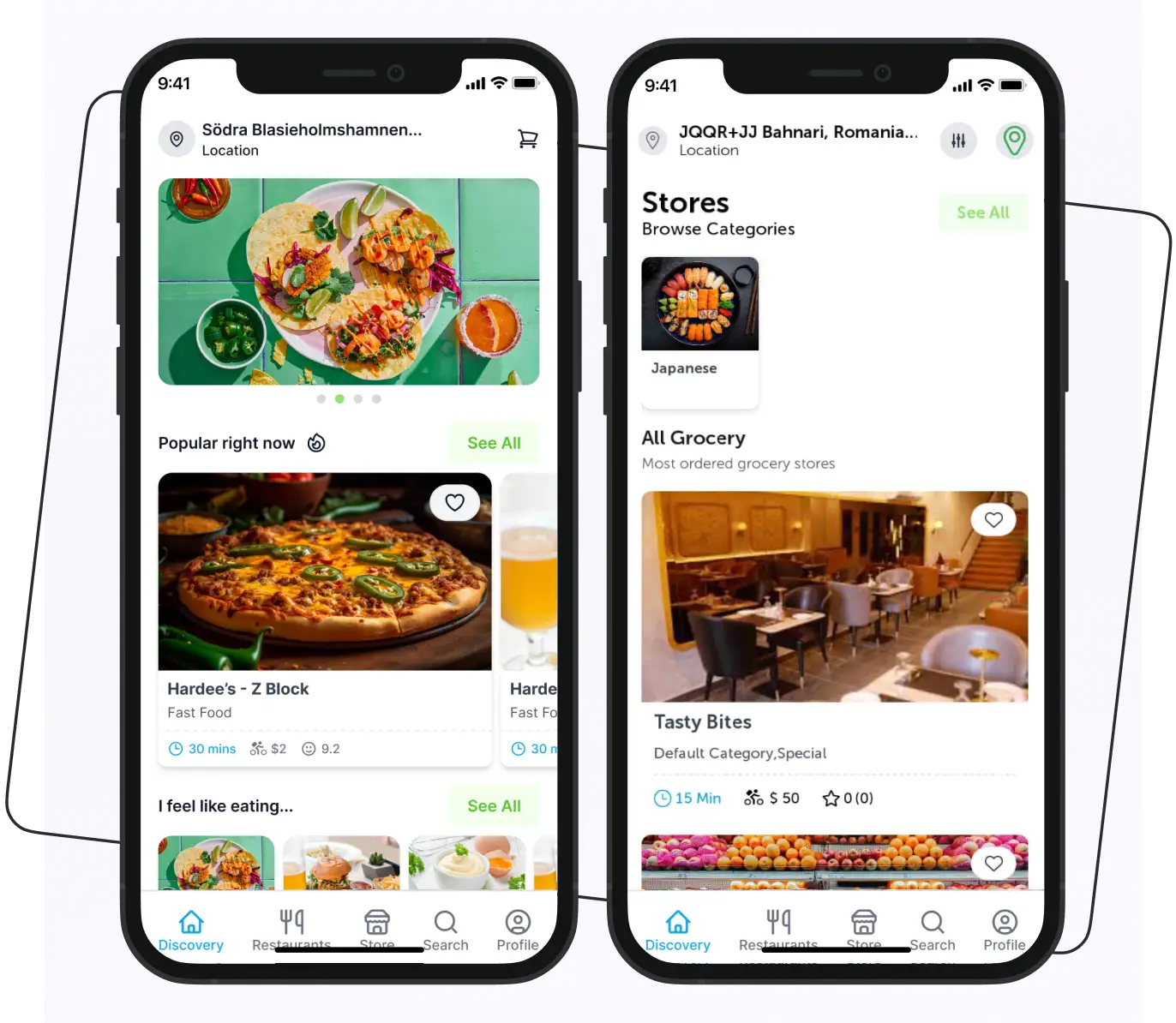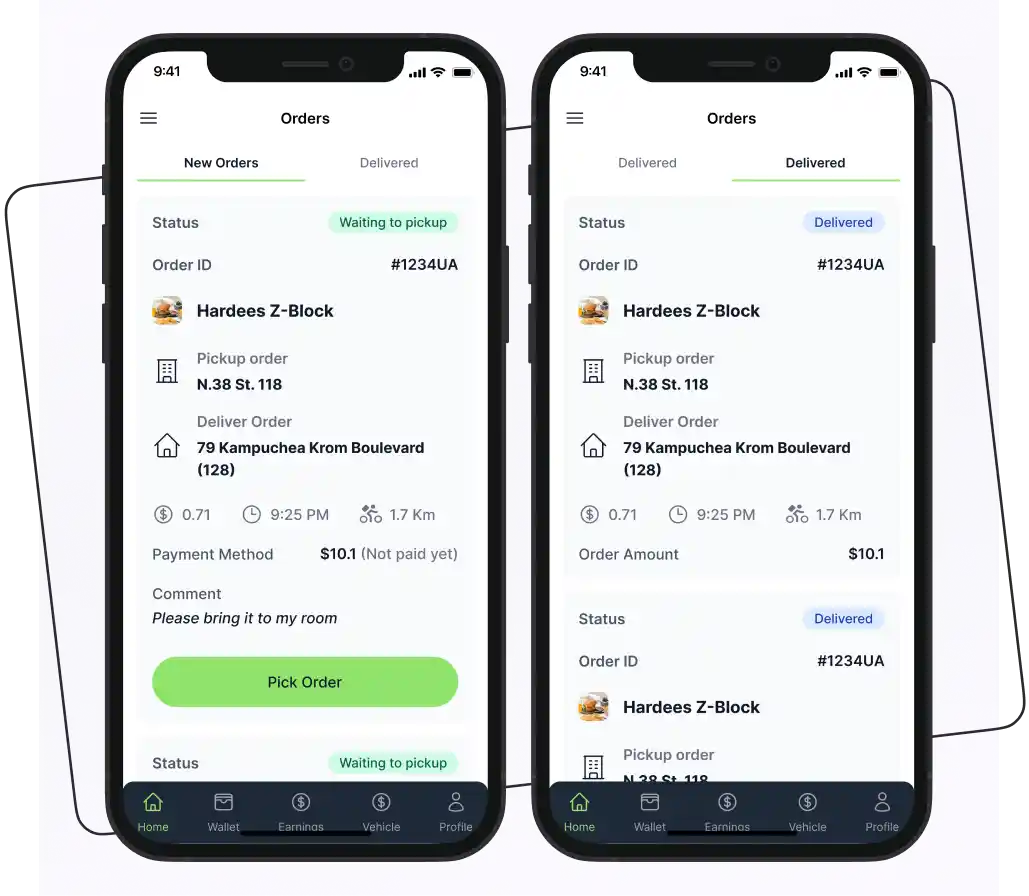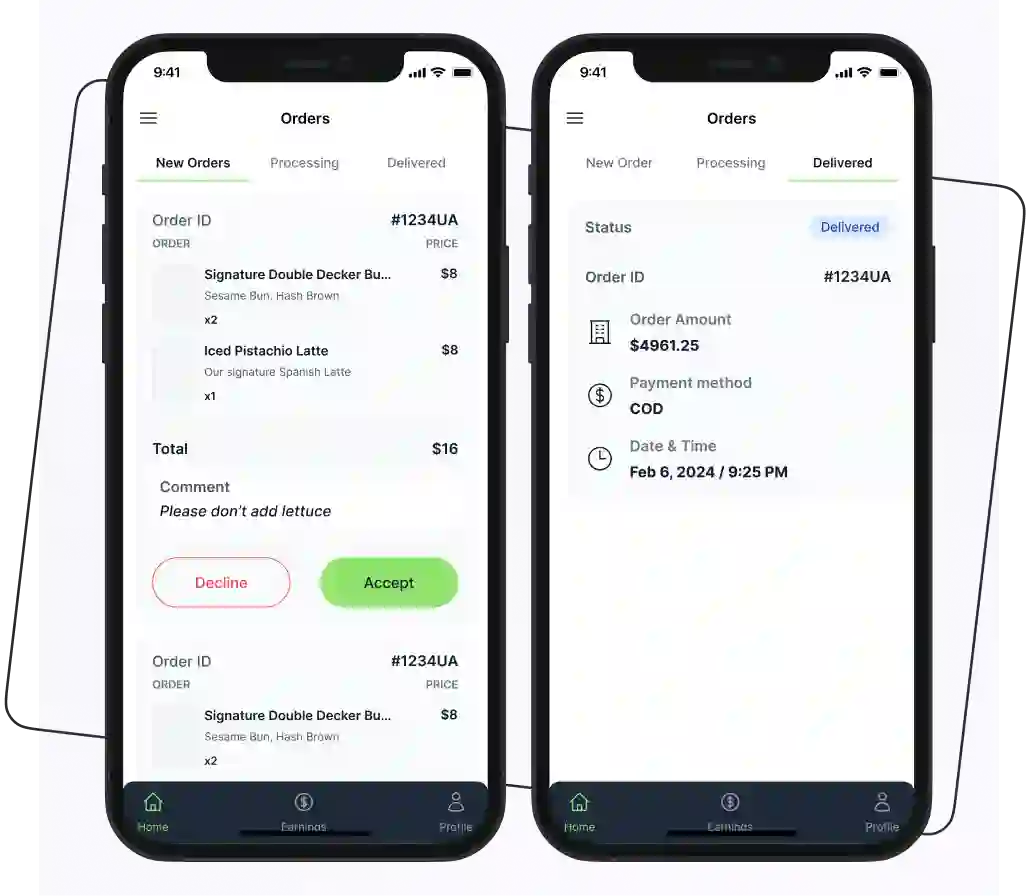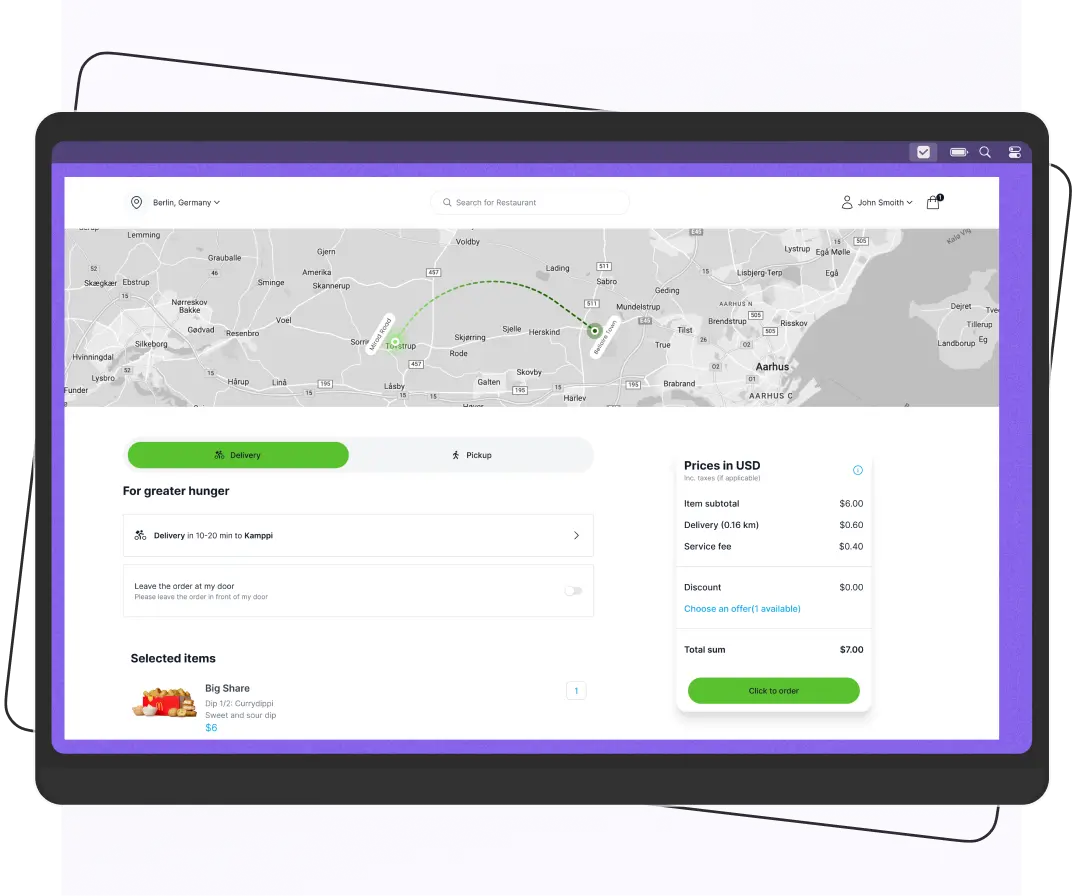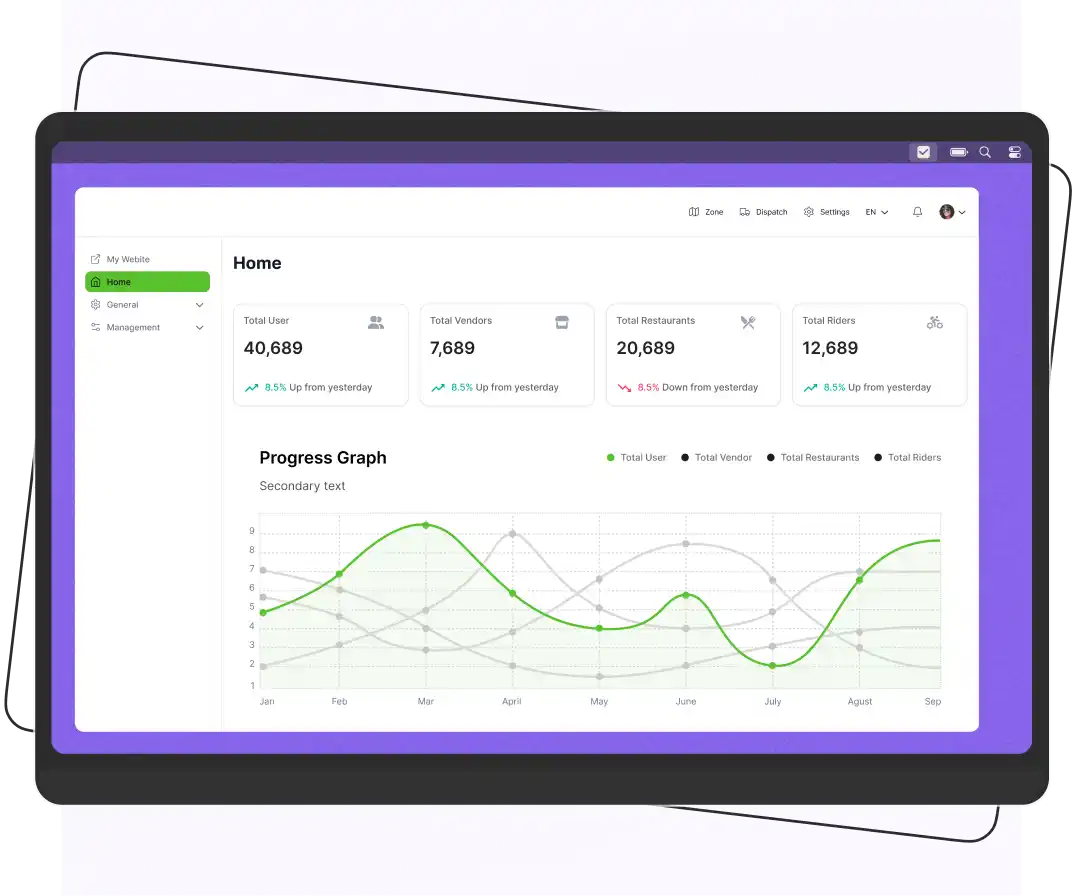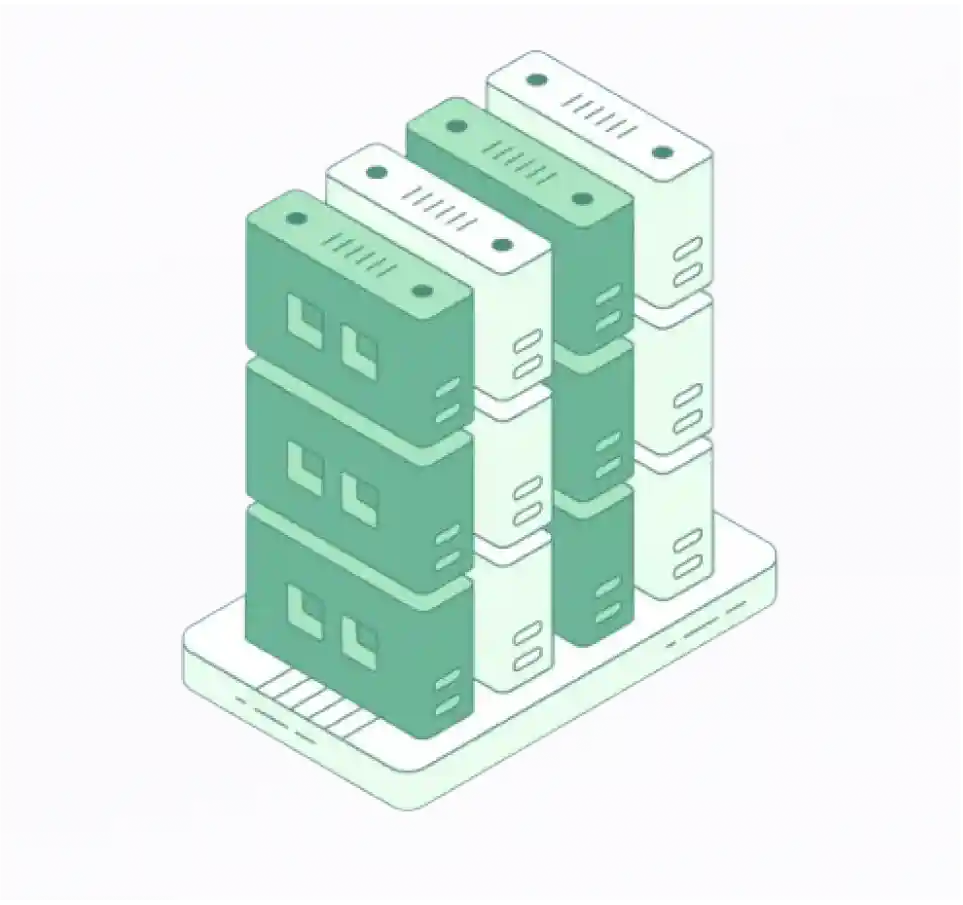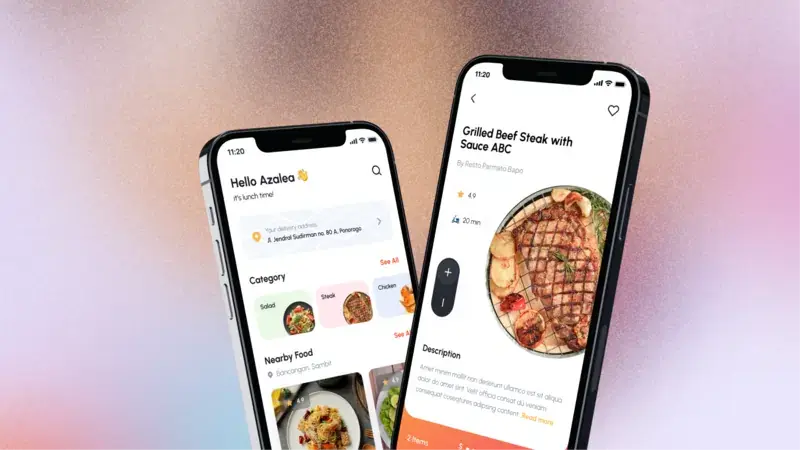
Key Takeaways
Market Growth: The online food delivery market is expanding rapidly, making it an ideal time to launch a food delivery app clone.
Features: Essential features include order tracking, restaurant management, in-app payments, and customer feedback.
Benefits: Customers enjoy convenience and personalized experiences, while restaurants benefit from low-cost setups and increased visibility.
Development: Steps include defining requirements, designing the UI/UX, developing, testing, launching, and maintaining the app.
Cost Factors: Costs vary based on features, platforms, design, and development approach.
Examples: Successful clones include GrubHub, DoorDash, Postmates, and Caviar.
Tired of seeing UberEats and DoorDash dominate your city’s food delivery scene? You’re not alone. Whether you’re a restaurant owner, an entrepreneur with a vision, or a startup ready to enter the local market, launching your app with a food delivery app clone isn’t just possible; it’s smarter than ever.
In 2025, customers expect their meals on time, with full transparency and minimal effort. And with the right tools, you don’t need to spend months (or millions) to build a platform that rivals the industry giants.
In this blog, we’re going beyond generic advice. You’ll learn what it takes to build a successful food delivery clone app from choosing the right tech stack to avoiding the costly mistakes that most newcomers make.
Statistics on Online Food Delivery
Below are some food delivery statistics to help you understand the importance of the latest industry trends surrounding the online food industry.
- On average, a 46 million number of customers use online food ordering apps. It is projected that this figure will rise to almost $54 million by 2024.
- Online meal delivery platforms are predicted to generate around $1.65 trillion in revenue by 2027, growing at a rate of almost 13% a year between 2023 and 2027.
- According to research, 70% of customers would place their orders online directly with the restaurant rather than using a third-party app.
- According to Statista, Asia is currently the largest online food delivery area globally, with approximately 63 percent of its users residing there as of 2024.
Supercharge your deliveries with Enatega.
Launch NowWhat is a Food Delivery App Clone?
The food delivery app clone is a ready-made food ordering and delivery solution that allows businesses to build their food delivery app at an affordable cost. It helps food delivery startups to tap into this market and provide a valuable service to their customers.
Moreover, the clone delivery app includes all the essential features of a successful food app, focusing on both the users and the businesses, such as:
- Order tracking
- Order management
- Restaurant management
- In-app payments
- Customer feedback
- Rider management
- Push notifications
Using the food app clone service, food businesses can transform their overall operations for the food delivery setup.
Workflow of Food Delivery App Clone
Here is a workflow of a food delivery app clone.
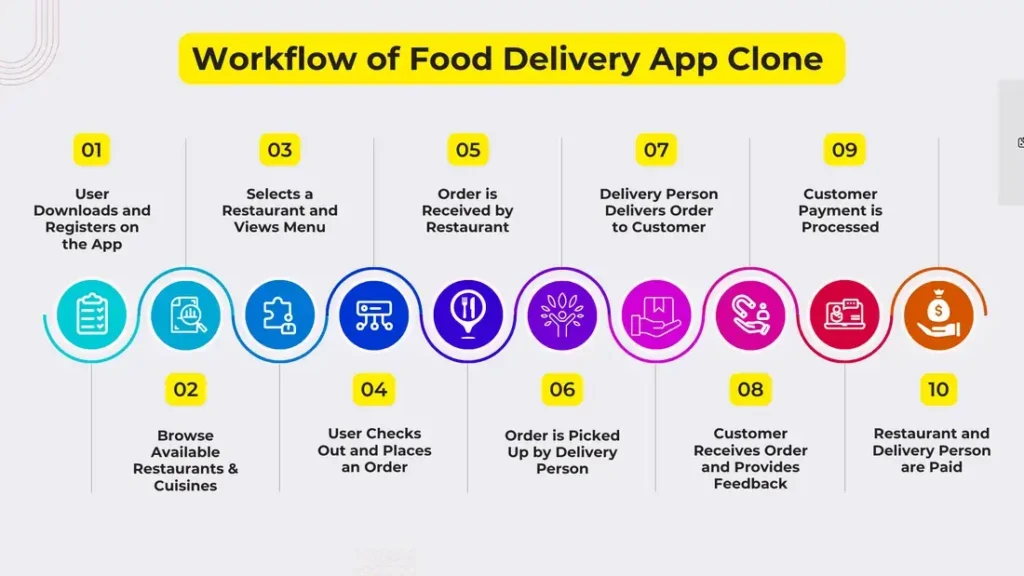
User Downloads and Registers on the App
- Provides personal information, contact details, and payment method
Browse Available Restaurants/Cuisines
- Users can filter/sort by various criteria (cuisine, rating, price range, etc.)
Selects a Restaurant and Views Menu
- Users can add items to their cart
User Checks Out and Places an Order
- Confirms order details, delivery address, and payment method
- Applies any available discounts or promo codes
Order is Received by the Restaurant
- The restaurant confirms the order and begins the preparation
Order is Picked Up by the Delivery Person
- The delivery person receives the order details and the customer’s address
Delivery Person Delivers Order to Customer
- Confirms successful delivery to the customer
Customer Receives Order and Provides Feedback
- Customers can rate the restaurant and delivery experience
Customer Payment is Processed
- The app charges the customer’s saved payment method
Restaurant and Delivery Person are Paid
- App disburses payments to the restaurant and the delivery person
Why Food Delivery App Clone?
The rise of online food ordering has significantly impacted the food industry, leading to the popularity of food ordering platforms and the development of food delivery clone apps. These apps offer numerous benefits to both customers and restaurants.
Let’s explore some of these advantages:
Benefits for Customers
| Benefits | Description |
| Wide Variety | Customers can get a wide range of restaurants on the app. They can easily explore new restaurants, discover various cuisines, and place orders from anywhere on the platform. |
| Convenience | Online food ordering platforms give customers the choice to tailor their orders according to their preferences. This personalized approach improves customer experience and builds trust. |
| Easy Payment Options | It is another main benefit of the online food delivery clone app. Secure and convenient payment options help customers pay with their preferred payment modes, such as credit/debit cards, digital wallets, and cash on delivery. |
| Personalized Ordering Experience | Online food ordering platforms give customers the choice to tailor their orders according to their preferences. This personalized approach improves customer experience and builds trust. |
| Easy Ordering Process | A food ordering app clone gives customers the choice to tailor their orders according to their preferences. This personalized approach improves customer experience and builds trust. |
Benefits for Restaurants
| Benefits | Description |
| Low Cost | The food app clone is a low-cost solution that helps businesses quickly develop and launch their online ordering platform without breaking the bank. Building an UberEats alternative app is costly and takes time. However, using the clone app is a budget-friendly way to address this issue, and you can customize the app according to your needs. |
| Easy to Use | Food delivery clone apps will help restaurant owners manage their business operations, orders, customers, and more from the app without hiring a lot of staff. |
| Flexible | The app can be customized to meet the needs of your business. This flexibility allows you to tailor the app to your brand and target audience. Also, it helps you stand out from the competition without having to invest a huge amount of money. |
| Scalable | A white-label food delivery app clone can be quickly scaled to meet the increasing demand. This scalability allows food businesses to grow easily without losing customers due to poor service or long wait times. |
| Increase Visibility | Food delivery clone apps enable restaurants to expand their customer base and reach a wider audience. By listing their menus on these platforms, they can attract new customers who might not have been aware of their offerings. This heightened visibility can ultimately lead to increased sales and revenue. |
| Increase Revenue | Launching the food clone app helps to improve your restaurant’s online visibility and you can get long-term growth opportunities. You can serve more customers efficiently, leading to higher sales. |
| Increase Accessibility | With an online food ordering system, restaurants can attract a broader customer base and cater to those who prefer to place orders online. |
| Easily Manage Ordering Process | Simplify the ordering process using the restaurant ordering system. By streamlining the process, restaurants can serve more customers, which will lead to higher sales. Also, it eliminates the miscommunication and reduces the chances of errors. |
Custom App Development vs. Clone App
The table below shows the key differences between custom app development and a clone app.
| Factors | Custom App Development | Clone App Development |
| Cost | Generally higher due to design and development costs. | Lower because it uses existing code and features. |
| Time to Market | Longer development time due to unique requirements. | Faster deployment as it mimics an existing app. |
| Scalability | Highly scalable; can adapt as needs grow. | Limited scalability; may require significant changes for new features. |
| Customization | Fully customizable to meet specific business goals. | Limited customization; primarily follows the original app’s structure. |
| User Experience | Tailored UX/UI for a target audience and brand identity. | May lack unique branding, and often follows the original app’s design. |
| Ownership | Full ownership of the intellectual property. | Potential IP issues if the original app is patented or trademarked. |
| Maintenance & Updates | Ongoing maintenance and updates tailored to needs. | Maintenance can be easier, but may not align with user expectations. |
| Market Differentiation | Unique features can create a competitive advantage. | Less differentiation; may compete in a crowded market. |
| Risk | Higher initial risk; requires market validation. | Lower risk; based on a proven concept, but may face legal challenges. |
| Integration | Can integrate with existing systems and technologies. | Limited integration capabilities; may not fit well with existing systems. |
Features of a Food Delivery App Clone
Building a highly scalable food delivery app solution with great features can give your customers and restaurants an unforgettable experience.
Below is a list of features you should add to your food app clone.
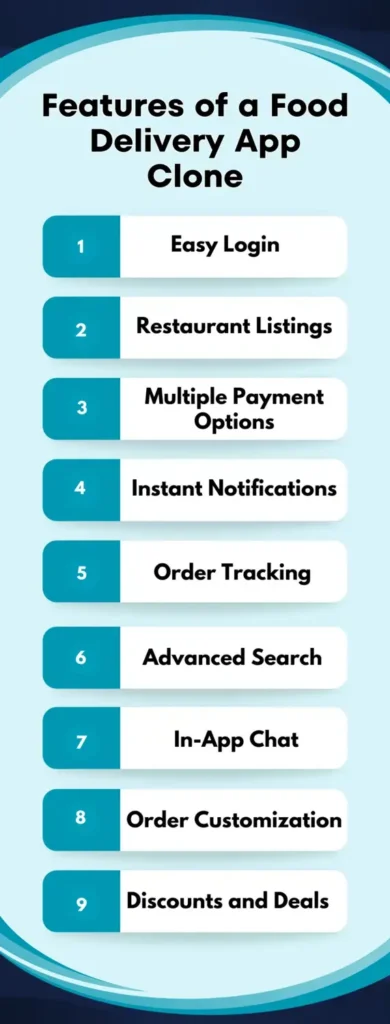
Easy Login
Users can create an account seamlessly using their email address, phone number, or social media accounts. They can log in securely to access the app’s features.
Restaurant Listings
The app has different restaurants available with proper information like restaurant details, menus, ratings, working hours, and others. It helps users to quickly get an overview of the restaurants and choose the one that suits their preferences.
Multiple Payment Options
It is the best feature that helps you to attract and retain more customers. The food delivery clone app provides various payment methods to customers for secure transactions.
Instant Notifications
Users can get instant alerts and notifications for order confirmations, updates, and promotional offers. Also, riders can get notifications for new orders with the order details, including the delivery address and any specific instructions.
Order Tracking
Customers will get real-time updates on their order status. They can track their orders in real-time from order preparation to delivery. This information can eliminate misunderstandings between users, restaurants, and riders and ensure a smooth process.
Advanced Search
Advanced search is a must feature of the successful food clone app. It allows users to search the restaurant by name, cuisine, delivery time, price range, and dietary preferences.
In-App Chat
Live chat is expected to continue to grow by as much as 150%. This feature helps customers to communicate with restaurants and riders seamlessly. It allows for quick clarifications, efficient problem-solving, and a better overall customer experience.
Order Customization
The Grubhub clone app development like solution helps users to customize their orders according to their preferences. Users can choose from various customization options like toppings, dressings, spice levels, dietary preferences (e.g., vegetarian, gluten-free), or portion sizes.
Restaurants also customize certain app elements to reflect their brand identity. This includes incorporating the restaurant’s logo, color scheme, and other branding elements within the app’s interface.
Discounts and Deals
Offering deals and discounts can entice new customers, as well as delight loyal and existing ones. It is the best way to keep the customers engaged and you can drive more traffic to your restaurant.
More Advanced and Unique Features of the Food Delivery Clone App
Here is a list of unique features that make your app stand out from the competition.
Order History
Order history is a convenient way for customers to keep track of current and past orders, including the status of orders. It saves time and effort, especially when ordering from the same restaurant or for users who have preferred items they regularly enjoy. In addition, they no longer have to remember the names of restaurants and dishes.
Order Scheduling
Users can schedule their delivery according to the time that fits their schedule. This helps customers to get their orders easily when they are available.
QR Codes
QR codes can be quite beneficial in online ordering platforms. Numerous people can use them to scan the menu, select their preferred dish, and conveniently process payments. Additionally, they can share their referral code on social media or with friends using the QR codes.
Grubhub, a well-known app for ordering and delivering meals, uses QR codes to enable speedy payment for users.
Voice Ordering
It allows customers to place an order at a restaurant using their voice and a smartphone, tablet, or other device. It offers an interactive and conversational ordering experience while reducing labor costs.
Voice integration is used by many food-ordering apps. For example, GrubHub integrates with Alexa so that users can order past meals again or specify an approximate delivery time for their order.
How to Create a Food Delivery App Clone?
Creating the food app clone involves several steps. Here’s a general outline of the process:
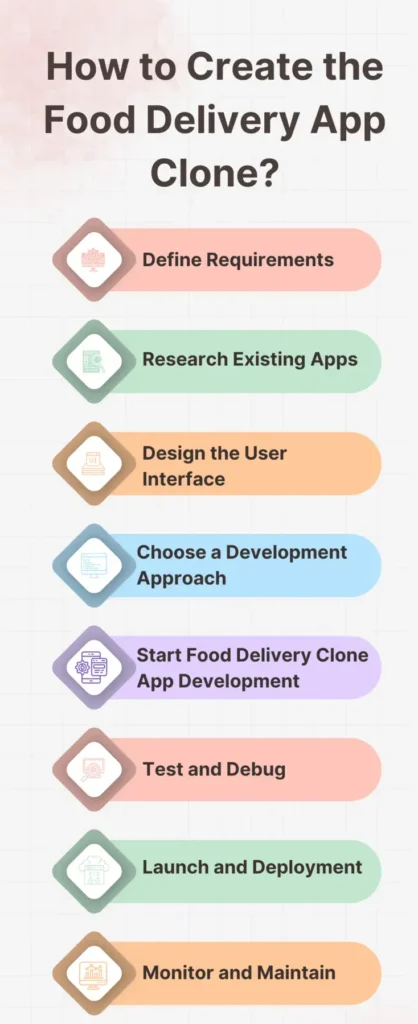
1. Define Requirements
Start by defining the requirements and features you want in your on-demand food app clone. Identify the essential functionalities such as user registration, restaurant listings, menu display, payment integration, order tracking, admin dashboard, and more.
2. Research Existing Apps
Study popular food delivery apps like Grubhub, Uber Eats, or DoorDash to understand their features, user experience, and overall flow. Analyze their strengths and weaknesses.
3. Design the User Interface
Create wireframes and design mockups of the app’s user interface (UI) and user experience (UX). Ensure a visually appealing and intuitive design that enhances the app’s usability.
4. Choose a Development Approach
Decide whether you want to develop the app from scratch or use existing frameworks or platforms. You can also consider using app development tools or app builders that provide pre-built components for faster development.
5. Start Food Delivery Clone App Development
Implement the user interface design and develop the frontend components of the app. Develop the server-side infrastructure and backend components that handle user authentication, order management, menu management, payment processing, and communication between the app and the database.
6. Test and Debug
Conduct thorough testing of the app to identify and fix bugs or issues. Perform testing on different devices and operating systems.
7. Launch and Deployment
Prepare the app for deployment by optimizing its performance, configuring server requirements, and ensuring data security. Publish the app on the respective app stores (Google Play Store, Apple App Store) or deploy it as a web app.
8. Monitor and Maintain
Once the app is launched, continuously monitor its performance, user feedback, and analytics. It’s essential to regularly update your app by fixing any bugs, adding new features, and applying security patches. These updates keep your app running smoothly, improve its functionality, and protect it from potential security threats.
Cost of Creating the Food Delivery Clone App Solution
Look at the table below and understand the cost of creating the food clone app.
| Cost Component | Estimated Range |
| App Development | $40,000 – $100,000 |
| UI/UX Design | $10,000 – $30,000 |
| Backend Development | $15,000 – $40,000 |
| Database Integration | $5,000 – $15,000 |
| Third-party integrations (e.g., payment gateways, mapping) | $5,000 – $20,000 |
| Hosting and Infrastructure | $3,000 – $10,000 per year |
| Maintenance and Updates | $5,000 – $15,000 per year |
| Marketing and Advertising | $10,000 – $50,000 |
| Total Estimated Cost | $90,000 – $280,000 |
Moreover, the cost of creating a food delivery clone app solution can vary depending on several factors, including:
App Features
The more extensive and advanced features you want in your food delivery clone app, the higher the development cost.
Platforms
The cost of creating a food delivery app clone can change depending on the platforms you choose. If you decide to develop the app for only one platform, like iOS or Android, it will generally be less expensive than developing for both platforms at the same time.
Design and User Experience
The complexity and customization of app design and user experience can impact the cost. A visually appealing and user-friendly interface may require more design effort, so it increases the development cost.
Development Approach
The development approach you choose can influence the cost. Developing a custom app from scratch will generally be more expensive compared to using pre-built components or existing frameworks, or platforms.
Development Team
The rates charged by the development team or agency you hire will significantly impact the overall cost. Rates can vary based on the team’s location, expertise, reputation, and experience level.
Maintenance and Support
Consider the ongoing costs for maintaining and updating the app, as well as providing customer support and server hosting.
Based on these factors, a rough estimate for the cost of creating a food clone app can range from $50,000 to $150,000 or more, depending on the specific requirements and complexity of your project.
Top Food Clone App Ideas for Food Delivery Business
Here are some top food clone app ideas for a food delivery business:
GrubHub Clone: Develop an app that replicates the functionality of the popular GrubHub platform, allowing users to order food from local restaurants for delivery or pickup.
DoorDash Clone: Create a clone of the DoorDash app, providing on-demand food delivery services from a wide range of restaurants in the user’s local area.
Postmates Clone: Build an app that mimics the Postmates model, offering delivery services not only for food but also for other products from local businesses.
Caviar Clone: Develop a clone of the Caviar app, focusing on delivering high-quality, gourmet meals from upscale restaurants.
Latest Trends in Food Delivery Clone Apps
Below are the latest trends in the food delivery app clones.
Integration of Advanced Technologies
The use of artificial intelligence (AI) is becoming more prevalent in food delivery apps. AI algorithms can provide personalized recommendations based on user behavior, order history, and external factors like weather and location.
Additionally, augmented reality (AR) allows customers to visualize menu items in their physical environment.
Focus on Hygiene and Transparency
Post-pandemic, customers are more conscious about hygiene and the nutritional content of their food. Apps are now expected to provide detailed information about food safety, hygiene practices of restaurants, and nutritional information, catering to the growing demand for transparency.
Marketing and Customer Retention Strategies
To attract and retain customers, food delivery apps are using various marketing strategies, including discounts, promotions, and loyalty programs. Engaging content and personalized marketing efforts are becoming standard practices to enhance customer engagement.
FAQs
1. What is an Uber Eats clone?
An Uber Eats clone is a mobile application that replicates the core features and functionality of the popular Uber Eats food delivery service. This Clone app provides a similar user experience, allowing customers to order meals from local restaurants and have them delivered quickly and conveniently, just like Uber Eats.
2. How much does a clone app cost?
The cost to develop a clone app can vary widely, ranging from $10,000 to $50,000 or more. The final cost depends on factors such as:
- The complexity of the features
- Development team’s experience
- Selection of platform (iOS, Android, or both)
3. What are the disadvantages of clone apps?
Below are a few disadvantages of clone apps.
Lack of brand recognition: Clone apps struggle to establish their own brand identity and may have difficulty gaining user trust and loyalty compared to the original app.
Difficulty competing with market leaders: Well-established apps like Uber Eats have significant resources, user bases, and market share, making it challenging for clone apps to gain traction and compete effectively.
4. How long does it take to build a food delivery clone app?
Building a clone app for food delivery can take anywhere from a few weeks to several months, depending on the complexity and features included.
A basic clone with essential features might take 2-4 months, while a more complex app with advanced features could take 6-12 months, or even longer.
Supercharge your deliveries with Enatega.
Launch NowConclusion
The market for the food delivery industry is booming as people prefer ordering online. This is the best time to launch an app that helps you succeed in the food delivery industry. Investing in a restaurant ordering system is definitely something worth considering.
If you can create an app that offers something unique and valuable to users, you can hire the food delivery clone app development company, Enatega. We have experts that deliver the best solution according to your needs.
Book a free demo with us and hire dedicated developers for food delivery app development.












 IOS
IOS Android
Android Web
Web